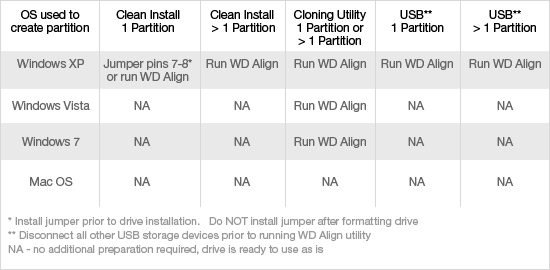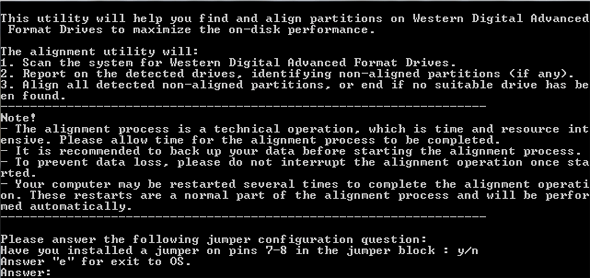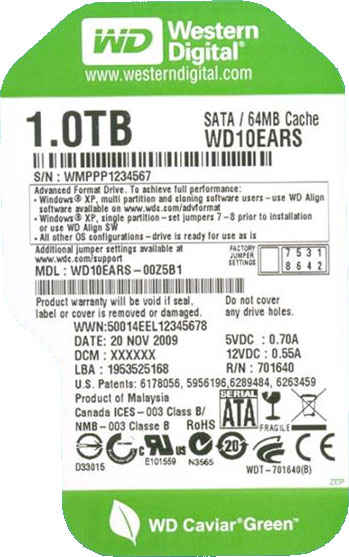Western Digital’s Advanced Format: The 4K Sector Transition Begins
by Ryan Smith on December 18, 2009 12:00 AM EST- Posted in
- Storage
What Operating Systems Are Affected
Now that we’ve dealt with what 4K sectors are, why Western Digital and other drive manufacturers are switching to them, and what the potential pitfalls of 512B emulation are, we can look at the specific cases where there are potential problems.
The big problem is that while the first work on 4KB sectors started in 1998, it wasn’t until after the launch of Windows XP that the matter came to a head. As a result the 5.x versions of Windows (2K, XP, 2K3, WHS) have no concept of 4KB sectors. Even though all operating systems will be seeing 512B sectors through the use of emulation technology on the drive controller, out of Windows only Win 6.x (Vista, 2008, Win7) and later have been programmed to take in to account the alignment issues we mentioned earlier. Win 5.xx in particular has a nasty habit of starting the first partition at LBA 63, which is 1 512B sector misaligned from a 4K sector boundary. In essence, the issue is that Win 5.x will always create a misaligned first partition and will have poor default performance as a result.
Although Win 5.x is the primary victim here, other versions of Windows can also be affected in edge cases. Along with the need for 4K-aware operating systems, drive imaging software needs to be 4K-aware. Otherwise such imaging software may inadvertently create misaligned partitions too. As such, Win 6.x is also affected by alignment issues when imaging software is used, as some (and perhaps all?) imaging products currently available will write misaligned partitions and/or clusters.

Notably, Linux and Mac OS X are not affected by this issue. Western Digital has tested both of these operating systems, and officially classifies them as not-affected. Ultimately we suspect that if you went back far enough you could find older versions of these OSes that are affected, but unlike Win 5.xx, there’s not a significant legacy user base to worry about. Along these lines, Linux and Mac OS X drive imaging products are similarly unaffected. In their testing, imaging tools such as SuperDuper didn’t run in to any alignment issues, so Linux and Mac OS X users are not affected in any way by 4K sectors. It’s only Windows and Windows imaging products that are affected.
In order to solve the misalignment issue, Western Digital is offering two solutions. The first solution for correcting misaligned partitions is specifically geared towards Win 5.x, and that is an option on the drive itself to use an offset. Through the jumpering of pins 7 and 8 on an Advanced Format drive, the drive controller will use a +1 offset, resolving Win 5.xx’s insistence on starting the first partition at LBA 63 by actually starting it at LBA 64, an aligned position. This is exactly the kind of crude hack it sounds like since it means the operating system is no longer writing to the sector it thinks its writing to, but it’s simple to activate and effective in solving the issue so long as only a single partition is being used. If multiple partitions are being used, then this offset cannot be used as it can negatively impact the later partitions. The offset can also not be removed without repartitioning the drive, as the removal of the offset would break the partition table.
The second method of resolving misaligned partitions is through the use of Western Digital’s WD Align utility, which moves a partition and its data from a misaligned position to an aligned position. This is the recommended solution for using multiple partitions under Win 5.xx, along with correcting any misaligned partitions generated by imaging software. For that matter we’d consider it the recommended solution for single-partition drives being used under Win 5.x too, as there’s no need to worry about offsets and breaking the partition table.

The utility is available for download from Western Digital’s site, and while it isn’t pretty (it’s a scripted CLI application) it gets the job done. The amount of time needed to run the utility is based on the amount of data that needs to be moved rather than the partition size (it simply ignores empty space), so it’s best to run the utility immediately after creating a partition or installing Windows, as there’s less data to move around.
Unfortunately, at this point the utility also serves as the only way to identify an Advance Format drive without physically looking at it. Looking at the ATA spec, it looks like there’s a provision for asking a drive its native sector size (regardless of 512B emulation) but at this point there’s no such tool beyond the WD Align utility itself. This in and of itself isn’t a big issue, but if you’re a techie that ever finds themselves working on an XP machine with a 1TB+ Western Digital drive, you’ll want to keep an eye open.
The First Drives & The Future
So what are the first Advanced Format drives and when are they due? The first drives will be Caviar Green drives using multiple 500GB platters – so the 1TB, 1.5TB, and 2TB Caviar Green. These drives will be shipping any day now, and can be identified through two different methods: 1) They all have 64MB of cache - the first WD Caviar Green drives to come with that much cache - and 2) They all have EARS in the drive model number, e.g. WD10EARS.

As we stated before, in spite of the benefits of 4K sectors, Western Digital is not pushing these drives as part of any major product launch. Rather they’re going to be quietly trickling in to the marketplace. Expect a price premium at first (as with any other new product) before settling down. We don’t have a drive on-hand to review, but from the fact that this is a low-key launch, WD isn’t painting any expectations of a performance difference, although this will be something to test in the future.
And on that note, expect to see similar launches from everyone else within the next year. The last IDEMA plan called for everyone to have 4K-sector drives by 2011, so everyone should be launching within the next year here. Everyone using 512B emulation is going to run in to the same teething issues with Win 5.x – so while other vendors may handle things slightly differently, ultimately everyone is going to be compensating for Win 5.x in some manner (in case it hasn’t been made clear here, these guys would be ecstatic for Win 5.x to go away quickly).
Farther down the road will be the exposure of 4K-sectors to the operating system itself. Linux and Win 6.x are set (and we believe that Mac OS X is too), the only limit right now is the desire to do a phased transition to make thing easier for legacy users. Since 4K-sector drives won’t work on Win 5.x at all, drive manufacturers can’t put them on the market so long as there’s a significant legacy base. 2014 – the year that extended support ends for WinXP – looks like a good year to finally complete the move to 4K sectors.










86 Comments
View All Comments
tophe - Friday, January 15, 2010 - link
I've bought this drive without knowledge of 4k technology and thus I've big problem because I'm using XP and W7 in my computer. I'd like to use this drive as single partition data drive, but will my data accesible from both OS? And then is it better to format it with W7 ( readable with xp w/out align software? ) or to format it with XP with the align software ( no trouble with W7 after? )? Or maybe I should change it for a normal 512bytes drive... If anyone can help I'd be very happy :)foxyshadis - Saturday, January 23, 2010 - link
You'll be fine, but you MUST partition the drive from windows 7 or with another 4k-aware tool. Do NOT partition it with XP. Both of them will work absolutely fine after that, there's no other tweaks you have to make to get XP working, since it has 512b emulation.carl0ski - Monday, December 28, 2009 - link
Since the workarounds basically require the partition to shift across 512 bytes,From the notes it looks like Windows 5.x will be able to read the drives without issue.
However the partition manager in the Windows installer on the original CD is broken and will not work. along with the partition manager in Computer Manager.
The windows installer didnt change much if at all from the blue screen wizard from NT 4 to Windows 2003 R2 (4.0 - 5.2)
Vista and 2003 use a different installer.
It is impossible or very unlikely that MS will issue new updated Windows Installation Disks that is the main problem/symptom.
If you create a Partition table in Vista / Windows 7 + you may be able to install from the 5.x CDs without trouble since the partitions already exist.
Bill Todd - Thursday, January 7, 2010 - link
For the next few years the new 4 KB sector drives will emulate older drives and thus be able to be used on any system that could use 512 B sector drives, right back to DOS x.x. They just won't *perform* as well for unaligned writes as the old drives did save in cases where the partition alignment has been fiddled to make things line up more efficiently.Note, by the way, that this partition alignment can be accomplished manually using older software: just adjust such that each primary partition starts on a physical 4 KB boundary (e.g., for the first partition on a disk start it on the 9th logical 'cylinder' of 63*255 512-byte sectors, since 8*63*255*512 is divisible by 4096). Logical partitions in the 'extended partition' need slightly different alignment to account for the fact that they don't include the first logical 'track' of 63 512-byte sectors, used by the 'extended partition boot record' in the same manner that the first logical 'track' on the disk is occupied by the 'master boot record'. Of course, mere partition alignment won't solve the performance problem if the file system residing in the partition doesn't observe neat 4 KB alignment internally.
(It also may be possible to change the size of the 'track' occupied by the MBR or EPBR to 64 512-byte sectors, which would be a cleaner solution but might confuse some software.)
Over the longer term, it's worth noting that Windows NT and its descendants have always been able to process data drives with sector sizes other than 512 bytes - they just can't boot from them. So save up a few boot drives for the time when no more 512-byte sector drives are available and keep using these systems as long as you care to.
taltamir - Friday, December 18, 2009 - link
it is fixed, in non ancient operating systems. Get windows 7...oh, you mean you want microsoft to upgrade their old OS for free to make it compatible with new technology?
Taft12 - Monday, December 21, 2009 - link
Yes, that is what I would like too. Service packs and patches have always been free.Calin - Sunday, December 20, 2009 - link
Yes, that would be great.Also, USB for Windows NT 4.0 would have been great at that time.
Ryan Smith - Friday, December 18, 2009 - link
XP has reached its Extended Support phase. Microsoft will not be releasing anything besides security updates.There may be other issues too in trying to make Win 5.x 4K-aware, but the fact of the matter is that they're not going to lift a finger while its in Extended Support anyhow.
mcnabney - Friday, December 18, 2009 - link
It appears the WHS is also impacted by this issue and is not in Extended Support. Should I be expecting a fix for my Home Server?Lukas - Sunday, December 20, 2009 - link
I doubt it. But there are several (easy and viable) workarounds.Companies that ship WHS systems may precreate the correct partitions and another option would be to create partition tables using a 4K aware partitioning utility, for example by booting into a Windows 7 Setup and creating the partitions there.